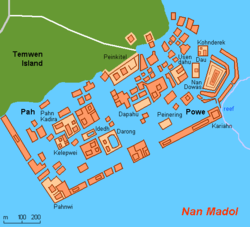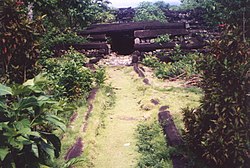Nan Madol: Perbedaan antara revisi
JohnThorne (bicara | kontrib) Tidak ada ringkasan suntingan |
JohnThorne (bicara | kontrib) Tidak ada ringkasan suntingan |
||
| Baris 16: | Baris 16: | ||
According to Pohnpeian legend, Nan Madol was constructed by twin sorcerers Olisihpa and Olosohpa from the mythical Western Katau, or Kanamwayso. The brothers arrived in a large [[canoe]] seeking a place to build an altar so that they could worship Nahnisohn Sahpw, the god of agriculture. After several false starts, the two brothers successfully built an altar off [[Temwen Island]], where they performed their rituals. In legend, these brothers levitated the huge stones with the aid of a flying dragon. When Olisihpa died of old age, Olosohpa became the first [[Saudeleur]]. Olosohpa married a local woman and sired twelve generations, producing sixteen other Saudeleur rulers of the Dipwilap ("Great") clan.{{#tag:ref|Hanlon (1988) notes differing accounts of the number of Saudeleur rulers, ranging from eight to seventeen, concluding that it is impossible to know this number for certain.<ref name=Hanlon/>{{rp|234}} |group=note}} The founders of the dynasty ruled kindly, though their successors placed ever increasing demands on their subjects. Their reign ended with the invasion by [[Isokelekel]], who also resided at Nan Madol, though his successors abandoned the site.<ref name=PlaceNames/><ref name=Native>{{cite book|title=The Native Polity of Ponape |volume=10 |series=Contributions to Anthropology |first=Saul H |last=Riesenberg |publisher=Smithsonian Institution Press |year=1968 |pages=38, 51 |url=http://books.google.com/books?id=JV-0AAAAIAAJ |accessdate=2012-01-01}}</ref><ref name=Joseph>{{cite book|title=The Lost Civilization of Lemuria: The Rise and Fall of the World's Oldest Culture |first=Frank |last=Joseph |publisher=Inner Traditions / Bear & Co |year=2006 |isbn=1-59143-060-7 |pages=21, |url=http://books.google.com/books?id=9tCybZagbqkC |accessdate=2012-01-01}}</ref><ref name=Goodenough>{{cite book|title=Under Heaven's Brow: Pre-Christian Religious Tradition in Chuuk |volume=246 |series=Memoirs of the American Philosophical Society |first=Ward Hunt |last=Goodenough |publisher=American Philosophical Society |year=2002 |isbn=0-87169-246-5 |page=293 |url=http://books.google.com/books?id=iOktNiIoMHAC |accessdate=2012-01-01}}</ref> |
According to Pohnpeian legend, Nan Madol was constructed by twin sorcerers Olisihpa and Olosohpa from the mythical Western Katau, or Kanamwayso. The brothers arrived in a large [[canoe]] seeking a place to build an altar so that they could worship Nahnisohn Sahpw, the god of agriculture. After several false starts, the two brothers successfully built an altar off [[Temwen Island]], where they performed their rituals. In legend, these brothers levitated the huge stones with the aid of a flying dragon. When Olisihpa died of old age, Olosohpa became the first [[Saudeleur]]. Olosohpa married a local woman and sired twelve generations, producing sixteen other Saudeleur rulers of the Dipwilap ("Great") clan.{{#tag:ref|Hanlon (1988) notes differing accounts of the number of Saudeleur rulers, ranging from eight to seventeen, concluding that it is impossible to know this number for certain.<ref name=Hanlon/>{{rp|234}} |group=note}} The founders of the dynasty ruled kindly, though their successors placed ever increasing demands on their subjects. Their reign ended with the invasion by [[Isokelekel]], who also resided at Nan Madol, though his successors abandoned the site.<ref name=PlaceNames/><ref name=Native>{{cite book|title=The Native Polity of Ponape |volume=10 |series=Contributions to Anthropology |first=Saul H |last=Riesenberg |publisher=Smithsonian Institution Press |year=1968 |pages=38, 51 |url=http://books.google.com/books?id=JV-0AAAAIAAJ |accessdate=2012-01-01}}</ref><ref name=Joseph>{{cite book|title=The Lost Civilization of Lemuria: The Rise and Fall of the World's Oldest Culture |first=Frank |last=Joseph |publisher=Inner Traditions / Bear & Co |year=2006 |isbn=1-59143-060-7 |pages=21, |url=http://books.google.com/books?id=9tCybZagbqkC |accessdate=2012-01-01}}</ref><ref name=Goodenough>{{cite book|title=Under Heaven's Brow: Pre-Christian Religious Tradition in Chuuk |volume=246 |series=Memoirs of the American Philosophical Society |first=Ward Hunt |last=Goodenough |publisher=American Philosophical Society |year=2002 |isbn=0-87169-246-5 |page=293 |url=http://books.google.com/books?id=iOktNiIoMHAC |accessdate=2012-01-01}}</ref> |
||
--> |
|||
== Fungsi dan Ciri == |
|||
==Purpose and features== |
|||
Pusat kota merupakan tempat kediaman khusus bagi para bangsawan dan upacara-upacara keagamaan yang dipimpin para imam. Jumlah penduduk ditaksir tidak melebihi 1.000 orang, kemungkinan malah kurang dari separuhnya. Meskipun banyak penghuni adalah para pemimpin, mayoritas adalah rakyat biasa. Nan Madol berfungsi, antara lain, sebagai suatu cara para penguasa Saudeleur untuk mengorganisir dan mengontrol mereka yang berpotensi menjadi pesaing dengan mengharuskan mereka tinggal di kota, bukan di daerah masing-masing yang sulit dimonitor aktivitasnya. |
|||
The elite centre was a special place of residence for the nobility and of mortuary activities presided over by [[priest]]s. Its population almost certainly did not exceed 1,000, and may have been less than half that. Although many of the residents were chiefs, the majority were [[commoner]]s. Nan Madol served, in part, as a way for the ruling Saudeleur chiefs to organize and control potential rivals by requiring them to live in the city rather than in their home districts, where their activities were difficult to monitor. |
|||
<!-- |
|||
Madol Powe, the mortuary sector, contains 58 islets in the northeastern area of Nan Madol. Most [[islet]]s were once occupied by the dwellings of priests. Some islets served special purpose: [[food]] preparation, [[canoe]] construction on Dapahu, and [[coconut]] oil preparation on Peinering. High walls surrounding [[tomb]]s are located on Peinkitel, Karian, and Lemenkou, but the crowning achievement is the royal mortuary islet of Nandauwas, where walls {{convert|18|–|25|ft|m}} high surround a central tomb enclosure within the main courtyard. |
Madol Powe, the mortuary sector, contains 58 islets in the northeastern area of Nan Madol. Most [[islet]]s were once occupied by the dwellings of priests. Some islets served special purpose: [[food]] preparation, [[canoe]] construction on Dapahu, and [[coconut]] oil preparation on Peinering. High walls surrounding [[tomb]]s are located on Peinkitel, Karian, and Lemenkou, but the crowning achievement is the royal mortuary islet of Nandauwas, where walls {{convert|18|–|25|ft|m}} high surround a central tomb enclosure within the main courtyard. |
||
Supposedly there was an escape tunnel beginning at the center of Nan Madol and boring down through the reef to exit into the ocean. Scuba divers continue to look for this "secret" route, but so far a complete tunnel has not been discovered. |
Supposedly there was an escape tunnel beginning at the center of Nan Madol and boring down through the reef to exit into the ocean. Scuba divers continue to look for this "secret" route, but so far a complete tunnel has not been discovered. |
||
--> |
|||
Nan Madol dikelilingi tembok raksasa yang diperkirakan tersusun dari 250.000.000 batu. Struktur bangunan di sana pun dibangun dari batu-batu monolit seberat 5 sampai 50 ton yang kemungkinan besar didatangkan dari pulau-pulau di sekitarnya. Yang menjadi pertanyaan, bagaimana caranya menyusun batu-batuan raksasa tersebut di tengah daratan buatan yang berlokasi di tengah laut? Para arkeolog mencoba merekonstruksi pembangunan bangunan-bangunan batu tersebut dengan berbagai metode pengangkutan, tetapi semuanya gagal. Setiap metode yang dicoba hanya mampu memindahkan batu dengan berat tak lebih dari beberapa ton saja. Tentu saja ini tak bisa menjelaskan struktur-struktur yang terbuat dari batu utuh seberat puluhan ton.<ref>[http://www.merdeka.com/gaya/6-situs-misterius-dunia-yang-keberadaannya-nyaris-terlupakan/kota-kuno-nan-madol-federasi-mikronesia.html Kota kuno Nan Madol, Federasi Mikronesia]</ref> |
|||
<!-- |
|||
==Food and water== |
==Food and water== |
||
On Nan Madol there is no [[fresh water]] or food; water must be collected and food grown inland. During [[Saudeleur]] rule, Pohnpeians brought essential food and water by boat.<ref name=Hanlon>{{cite book|title=Upon a Stone Altar: A History of the Island of Pohnpei to 1890 |volume=5 |series=Pacific Islands Monograph |first=David L |last=Hanlon |publisher=University of Hawaii Press |year=1988 |isbn=0-8248-1124-0 |pages=13–25 |url=http://books.google.com/books?id=OzgF5vZByVoC |accessdate=2012-01-01}}</ref><ref name=Morgan/><ref name=Ballinger>{{cite book|title=Lost City of Stone: The Story of Nan Madol, the "Atlantis" of the Pacific |first=Bill Sanborn |last=Ballinger |publisher=Simon and Schuster |year=1978 |isbn=0-671-24030-7 |pages=45–8 |url=http://books.google.com/books?id=l6oSAQAAIAAJ |accessdate=2011-12-31}}</ref> The Saudeleur received food at a particular islet — first Peiniot, and later the closer Usennamw.<ref name=Morgan/><ref name=PlaceNames/> |
On Nan Madol there is no [[fresh water]] or food; water must be collected and food grown inland. During [[Saudeleur]] rule, Pohnpeians brought essential food and water by boat.<ref name=Hanlon>{{cite book|title=Upon a Stone Altar: A History of the Island of Pohnpei to 1890 |volume=5 |series=Pacific Islands Monograph |first=David L |last=Hanlon |publisher=University of Hawaii Press |year=1988 |isbn=0-8248-1124-0 |pages=13–25 |url=http://books.google.com/books?id=OzgF5vZByVoC |accessdate=2012-01-01}}</ref><ref name=Morgan/><ref name=Ballinger>{{cite book|title=Lost City of Stone: The Story of Nan Madol, the "Atlantis" of the Pacific |first=Bill Sanborn |last=Ballinger |publisher=Simon and Schuster |year=1978 |isbn=0-671-24030-7 |pages=45–8 |url=http://books.google.com/books?id=l6oSAQAAIAAJ |accessdate=2011-12-31}}</ref> The Saudeleur received food at a particular islet — first Peiniot, and later the closer Usennamw.<ref name=Morgan/><ref name=PlaceNames/> |
||
| Baris 69: | Baris 71: | ||
{{bangunan-stub}} |
{{bangunan-stub}} |
||
[[Kategori:Situs arkeologi di Federasi Mikronesia]] |
[[Kategori:Situs arkeologi di Federasi Mikronesia]] |
||
[[Kategori:Megalit]] |
|||
Revisi per 25 Juni 2014 13.20

Nan Madol adalah reruntuhan kota yang terletak di sebelah timur pulau Pohnpei. Kota ini sebelumnya merupakan ibukota Dinasti Saudeleur hingga sekitar tahun 1628.[1][note 1] Saat ini, reruntuhan Nan Madol terletak di distrik Madolenihmw, Federasi Mikronesia. Kota ini terdiri dari serangkaian pulau buatan kecil yang terhubung oleh jaringan kanal.[1] Reruntuhan ini beserta tembok batunya meliputi wilayah sepanjang 1,5 km dan selebar 0,5 km dan terdiri dari sekitar 100 pulau buatan.
Nama Nan Madol berarti "ruang di antara" dan merupakan rujukan kepada kanal di reruntuhan ini. Menurut Gene Ashby dalam bukunya Pohnpei, An Island Argosy, nama aslinya adalah Soun Nan-leng (Karang Surga).[7] Reruntuhan ini sering dijuluki sebagai "Venesia di Pasifik."[8]
Sejarah




Nan Madol merupakan pusat upacara dan politik Dinasti Saudeleur, yang menyatukan sekitar 25.000 penduduk Pohnpei sampai kira-kira tahun 1628.[1] Terletak terpisah di antara pulau utama Pohnpei dan pulau Temwen, telah dilacak adanya aktivitas manusia sejak abad pertama atau kedua Masehi. Pada abad ke-8 dan ke-9 pembangunan islet (pulau kecil) ini mulai dilakukan, tetapi arsitektur megalit kemungkinan baru dimulai pada abad ke-12 atau awal abad ke-13.
Fungsi dan Ciri
Pusat kota merupakan tempat kediaman khusus bagi para bangsawan dan upacara-upacara keagamaan yang dipimpin para imam. Jumlah penduduk ditaksir tidak melebihi 1.000 orang, kemungkinan malah kurang dari separuhnya. Meskipun banyak penghuni adalah para pemimpin, mayoritas adalah rakyat biasa. Nan Madol berfungsi, antara lain, sebagai suatu cara para penguasa Saudeleur untuk mengorganisir dan mengontrol mereka yang berpotensi menjadi pesaing dengan mengharuskan mereka tinggal di kota, bukan di daerah masing-masing yang sulit dimonitor aktivitasnya. Nan Madol dikelilingi tembok raksasa yang diperkirakan tersusun dari 250.000.000 batu. Struktur bangunan di sana pun dibangun dari batu-batu monolit seberat 5 sampai 50 ton yang kemungkinan besar didatangkan dari pulau-pulau di sekitarnya. Yang menjadi pertanyaan, bagaimana caranya menyusun batu-batuan raksasa tersebut di tengah daratan buatan yang berlokasi di tengah laut? Para arkeolog mencoba merekonstruksi pembangunan bangunan-bangunan batu tersebut dengan berbagai metode pengangkutan, tetapi semuanya gagal. Setiap metode yang dicoba hanya mampu memindahkan batu dengan berat tak lebih dari beberapa ton saja. Tentu saja ini tak bisa menjelaskan struktur-struktur yang terbuat dari batu utuh seberat puluhan ton.[9]
Catatan
- ^ Dinasti Saudeleur berkuasa selama kurang lebih 500 tahun.[2] Menurut legenda, dinasti tersebut jatuh pada tahun 1500an,[3] namun menurut penelitian arkeologi reruntuhan Saudeleur berasal dari sekitar tahun 1628.[4][5][6]
Referensi
- ^ a b c Nan Madol, Madolenihmw, Pohnpei William Ayres, Department of Anthropology University Of Oregon, Accessed 26th September 2007
- ^ Hanlon, David L (1988). Upon a Stone Altar: A History of the Island of Pohnpei to 1890. Pacific Islands Monograph. 5. University of Hawaii Press. hlm. 13–25. ISBN 0-8248-1124-0. Diakses tanggal 2012-01-01.
- ^ Cordy, Ross H (1993). The Lelu Stone Ruins (Kosrae, Micronesia): 1978-81 Historical and Archaeological Research. Asian and Pacific Archaeology. Social Science Research Institute, University of Hawaii at Manoa. hlm. 14, 254, 258. ISBN 0-8248-1134-8. Diakses tanggal 2011-12-31.
- ^ Morgan, William N (1988). Prehistoric Architecture in Micronesia. University of Texas Press. hlm. 60, 63, 76, 85. ISBN 0-292-76506-1. Diakses tanggal 2011-12-31.
- ^ Panholzer, Tom; Rufino, Mauricio (2003). Place Names of Pohnpei Island: Including And (Ant) and Pakin Atolls. Bess Press. hlm. xiii, 21, 22, 25, 38, 48, 56, 63, 71. 72, 74, 104. ISBN 1-57306-166-2. Diakses tanggal 2011-12-31.
- ^ Micronesica. University of Guam. 1990. hlm. 92, 203, 277. Diakses tanggal 2011-12-31.
- ^ Ashby, Gene; 'Pohnpei, An Island Argosy'; Publisher: Rainy Day Pr West; Revised edition (June 1987); ISBN 0-931742-14-5; ISBN 978-0-931742-14-9
- ^ http://www2.canada.com/vancouvercourier/news/travel/story.html?id=d7601625-fafe-46f4-b1d1-5c18837881cf
- ^ Kota kuno Nan Madol, Federasi Mikronesia
